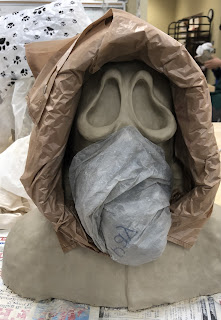 |
| Solid Scream sculpture, with the thin parts covered while the thick parts are left to dry out before hollowing |
 |
| Scream, by Amanda Goodrich, after hollowing |
 |
| Amanda did a nice job of capturing the sense of weight in the cloak |
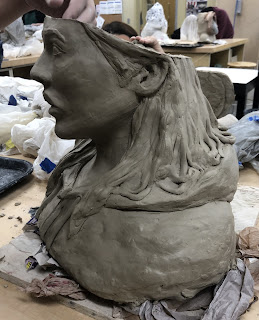 |
| After building the solid sculptures, we let the surface dry, then cut the pieces apart in order to remove the armature and remove the excess clay |
This quarter has also felt like it absolutely flew by. Maybe it always feels like that, and maybe time is always relative, but it feels like I just blinked and we're already at week 7! On the other hand, I counted the other day and was surprised to realize that it has been less than 3 weeks since I started my hormone therapy to try to keep the cancer from returning.
 |
| Kate Winslet as Clementine (from Eternal Sunshine of the Spotless Mind) by Thai See |
This quarter's classes are larger than the ones I had last fall. Though they aren't full, there are enough students to make the studio space fun and energizing. It helps quite a lot, actually, that most students are working hard. I have always observed that a solid group of students working hard in the studio, coming to class regularly, and working in the studio outside of class has a positive impact on everyone in the class.
 |
| Thai really managed to capture the hair texture as well as the nearly-crying expression |
Students feed of each other's energy to create a studio atmosphere unique to each class or quarter. When they come in to the studio outside of class and other people are there, or when they can arrange to come in a the same time as their classmates, it makes it easier and more pleasant to stay and work for longer periods of time. When they can work at the same time as classmates, they compare notes, borrow from each other, and help each other along in their work.
 |
| Charlie and Clementine during their hollowing out phase |
This is the organic process that makes a shared studio so great, and I try to replicate in a critique when I ask students to give each other helpful feedback and suggestions. Usually, in a shared studio where folks are already talking during and between classes, a more formal critique works well because students feel more comfortable discussing their work and giving suggestions, not just compliments to classmates.
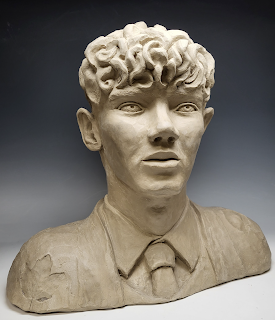 |
| Charlie from Heartstopper by Amy Matson |
In a studio where folks don't really know each other or don't feel comfortable, it seems like the critique ends up being more awkward and more focused on compliments than on suggestions for improvement or sharing ideas.
 |
| Amy managed to capture the facial features as well as the hair texture and added leaf imprints to the shoulders to reference the imagery in the story |
Trying to replicate the sharing and support of a shared studio in an online class is tough because students don't know each other as well and because they aren't really together. It's harder to make a connection via typing comments and sometimes waiting hours or days for a response.
 |
| The plastic in the middle is covering the armature that most students used to hold up their heads during sculpting |
Last fall, because of the social distancing requirements and the more limited class time, I chose to keep the critiques online and I really, really missed critique time in both classes. This fall I immediately made the adjustment to come back to in person critiques. I also took back the extra on-campus class time that had been shifted online. We also no longer have to maintain social distancing, though
the studio is spacious enough that we can keep that distance much of the time.
 |
| Nien Nunb from Star Wars by Carlos Garcia Alcantar |
This quarter, in the hand-building class, I returned to the structure I'd had before the pandemic. They start the class divided into four groups, each of which starts with a particular tool or
technique:
coils,
slabs, the
extruder, or
3D Printer. A week or so into the quarter they switch to a new technique. In the middle of the quarter everyone comes together and builds an expressive portrait, then they return to the two techniques they didn't do the first time around.
 |
| Nien Nunb has such interesting surface layers on his face that it's easy to miss the smirking expression when you first look at him |
I love this format because they get to try so many different techniques. It isn't really feasible to demonstrate all this during class, but because I've flipped the class, I can assign the demos as homework. They also couldn't all fit on one slab roller, one extruder, or the 3D printer at once, so dividing them up into groups of 3 or 4 allows them all better access to the tools. By the time they switch techniques the first time, they can often help each other. By the time of their first critique, they are able to give advice to classmates who move on to those techniques later in the class.
 |
| Winifred from Hocus Pocus, during the hollowing process, work in progress by Derek Arneecher |
For the solid portrait, students are asked to choose a particular person, animal, or creature, real or fictional and create a dynamic or expressive portrait. The idea is to work from photos or from real life and capture something of the real expression or position of that subject. Most students
work on an armature and most choose either the full body of an animal, or the bust of a person or humanoid form.
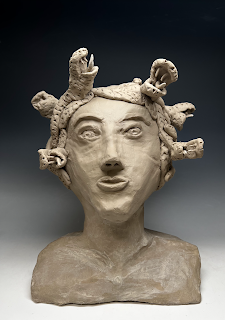 |
| Medusa by Valeria Alvarez |
This quarter most students picked characters from TV or movies, including a couple of non-human creatures from Star Wars, a particular Spiderman, and the Scream mask guy. There were four pets (two dogs and two leopard geckos) and Medusa.
 |
| Two geckos in progress by Brooke Mason |
The students were asked to work from photos and to take or find photos of one position or expression from multiple points of view. Sometimes students choose to bring in a physical object, like a stuffed animal or statuette, or
work from life by sculpting their classmate.
 |
| Dog on a pillow, work in progress by Thunder Morales |
This is always harder when the subject is a pet, because pets won't always pose in the right position for long enough to take photos from multiple views. This is especially hard when the pet is no longer with us.
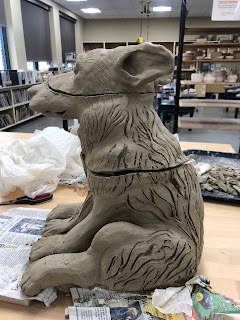 |
| Dog after hollowing before he was put back together |
This can also be tricky with famous people or characters from TV or movies for the same reason. Family and friends can be easier to get the photos of, but then it is more frustrating when minor details are off, because we know those faces so well.
 |
| Dog by Yarelli Sanchez |
This quarter had some fun expressions or poses and several students did a particularly nice job of capturing some of the subtleties of facial expressions.
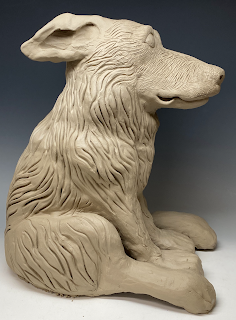 |
| Besides the soft bumpy fur texture, Yarelli captured the dog's funny sitting position and the idiosyncratic expression in the lips |
Now that the builds are (mostly) done, we need to dry them slowly to prevent cracks. Assuming that students thinned out their walls enough when they were hollowing, they should all survive the firing and be
ready for glazing late this month or early next.
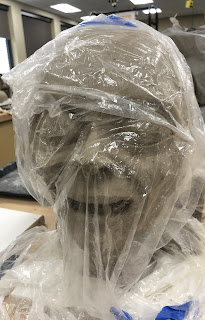 |
| Gollum by Amy Matson, work alarmingly covered by plastic to keep it wet |




















Your student's work is simply amazing! Art making is best when discussion and collaboration are involved. The exchange of ideas and working out problems is essential in a class. Art is all about solving problems. Your approach to teaching openly allows this to happen.
ReplyDelete